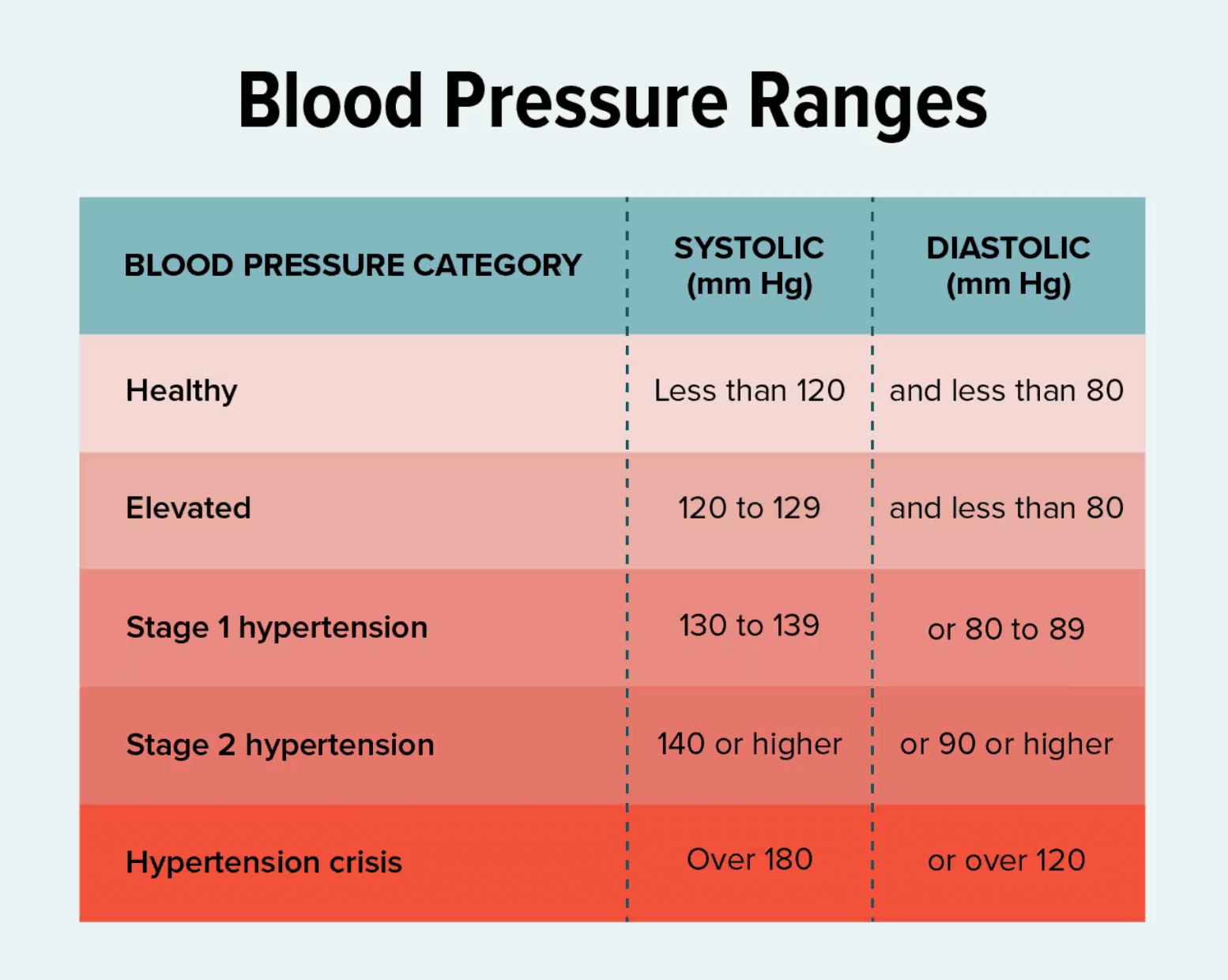Understand your blood pressure chart to understand your blood pressure. High blood pressure, or hypertension, is a serious health condition that affects millions worldwide. It often shows no symptoms, earning it the nickname "the silent killer," yet it significantly increases the risk of heart disease, stroke, kidney problems, and other health issues. Understanding your blood pressure readings and adopting healthy lifestyle habits are crucial for managing and preventing hypertension.
Decoding Your Blood Pressure Chart
Blood pressure is measured in millimeters of mercury (mmHg) and is expressed as two numbers:
- Systolic:The top number represents the pressure in your arteries when your heart beats (contracts).4
- Diastolic: The bottom number represents the pressure in your arteries when your heart rests between beats.
Here's a general guide to blood pressure categories for adults. See the blood pressure chart:
| Category | Systolic (mmHg) | Diastolic (mmHg) | What to Do |
| Normal | Less than 120 | Less than 80 | Maintain a healthy lifestyle. |
| Elevated | 120-129 | Less than 80 | Adopt a healthy lifestyle. |
| Stage 1 Hypertension | 130-139 | 80-89 | Healthy lifestyle changes and possibly medication. |
| Stage 2 Hypertension | 140 or higher | 90 or higher | Healthy lifestyle changes and likely more than one medication. |
| Hypertensive Crisis | Higher than 180 | Higher than 120 | Seek immediate medical attention. |
It's important to have your blood pressure checked regularly by a healthcare professional. A single high reading doesn't always mean you have hypertension, as blood pressure can fluctuate throughout the day. Doctors usually diagnose high blood pressure based on multiple readings taken on different occasions. View the blood pressure chart and Ranges:

Natural Strategies to Lower Blood Pressure
Adopting a heart-healthy lifestyle can significantly impact your blood pressure. Based on the blood pressure chart, you can see in what range you are in. Here are some natural ways to help lower it:
- Eat a Healthy Diet: Focus on fruits, vegetables, whole grains, and lean proteins. The DASH (Dietary Approaches to Stop Hypertension) diet is specifically designed to lower blood pressure.5 Reduce saturated and unhealthy fats, cholesterol, and processed foods.
- Reduce Sodium Intake: Even a small reduction in dietary sodium can make a difference. Aim for less than 2,300 milligrams (about 1 teaspoon of salt) per day, and ideally closer to 1,500 mg for most adults. Read food labels carefully and choose low-sodium options.
- Increase Potassium Intake: Potassium helps balance sodium in the body and can lower blood pressure. Good sources include bananas, sweet potatoes, spinach, and beans.
- Engage in Regular Physical Activity: Aim for at least 30 minutes of moderate-intensity exercise most days of the week. Activities like brisk walking,6 jogging, swimming, or cycling can help7 lower blood pressure.
- Maintain a Healthy Weight: Losing even a small amount of weight if you're overweight or obese can have a positive impact on blood pressure.
- Limit Alcohol Consumption: Moderate alcohol intake is defined as up to one drink per day for women and up to two drinks per day for men. Excessive alcohol can raise blood pressure.
- Manage Stress: Chronic stress can contribute to high blood pressure. Practice relaxation techniques like yoga, meditation, or deep breathing8 exercises.
- Quit Smoking: Nicotine constricts blood vessels and raises blood pressure. Quitting smoking has numerous health benefits, including lowering blood pressure.
- Get Enough Sleep: Poor sleep can negatively affect blood pressure. Aim for 7-9 hours of quality sleep each night.
The Potential Role of Beetroot Powder
Among these natural strategies, beetroot powder has gained attention for its potential to help lower blood pressure. Here's how it works:
- Rich in Nitrates: Beetroots are naturally high in nitrates, compounds that your body converts into nitric oxide.
- Nitric Oxide and Vasodilation: Nitric oxide is a molecule that helps relax and widen blood vessels (vasodilation). This improved blood flow reduces the pressure against the artery walls, leading to lower blood pressure.
Scientific Evidence:
Several studies have investigated the effects of beetroot juice and beetroot powder on blood pressure. Research suggests that:
- Consuming beetroot products can lead to a significant reduction in both systolic and diastolic blood pressure in some individuals.
- The blood pressure-lowering effects can be observed within hours of consumption.
- Regular intake may contribute to long-term blood pressure management as part of a healthy lifestyle.
How to Incorporate Beetroot Powder:
Beetroot powder is a convenient way to harness the potential benefits of beets. You can easily add it to:
- Smoothies: Blend a teaspoon or two for a nutritional boost.
- Juices: Mix it with water or other vegetable juices.
- Soups and Sauces: Stir it in for added nutrients and a subtle earthy flavor.
- Baked Goods: Incorporate it into muffins or pancakes.
Important Considerations:
While beetroot powder shows promise, it's essential to keep in mind:
- Individual Responses Vary: The effect on blood pressure can differ among individuals.
- Not a Replacement for Medication: Beetroot powder should not be used as a substitute for prescribed blood pressure medication. Always follow your doctor's advice.
- Potential Interactions: If you are taking blood pressure medication or have any underlying health conditions, consult your doctor before regularly using beetroot powder to avoid potential interactions or adverse effects.
- Mild Side Effects: Some people may experience beeturia (red or pink urine or stool), which is harmless.
Conclusion
Managing blood pressure is a lifelong commitment that often involves a combination of lifestyle changes and medication. Understand your blood pressure chart to see your range. Natural strategies, including incorporating nutrient-rich foods like beetroot powder, can play a supportive role in maintaining healthy blood pressure levels. By understanding your blood pressure readings and chart and adopting a holistic approach to your well-being, you can significantly reduce your risk of hypertension-related complications. Always consult with your healthcare provider for personalized advice and management of your blood pressure.
Stamox
Stamox is made from the best beetroot we can find, and is tested for quality and purity both at the food laboratory approved by the Norwegian Food Safety Authority, and at the anti-doping laboratory in Cambridge as required by OlympiaToppen, and is recommended by RELIS at Haukeland University Hospital in Bergen. Stamox is not a medicine, and is not intended as a substitute for medicines prescribed by a doctor.
"If you drink a glass of Stamox a day, you can expect to reduce your blood pressure by 8 systolic points, and 4 diastolic points." - Dr. Nils P. Reither
References
What's in Your Beet Juice? Nitrate and Nitrite Content of Beet Juice Products Marketed to AthletesGallardo & Coggan https://pmc.ncbi.nlm.nih.gov/articles/PMC8512783/






